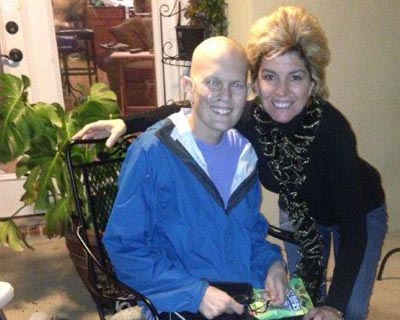Nick and Dr. Gaddy. Nick's leukemia, which Dr. Gaddy helped diagnose, is now in remission.
It was just a last-minute trip to the ophthalmologist for a quick prescription for contact lenses before he left town for a soccer tournament. But by day’s end, 15-year-old Nick Myers was in an ambulance on his way to the hospital for emergency treatment to save his life.
His mother, Jennifer, was in shock. Nick just had a physical a few months earlier. He got a clean bill of health. What did ophthalmologist Gene Gaddy, MD, see that no one else saw?
It was chance that brought Nick to Dr. Gaddy’s office. His refill had run out and a new contact lens prescription required an eye exam. But there was no time to make an appointment at WalMart as she usually does, so Jennifer called Dr. Gaddy, the father of one of Nick’s soccer teammates, hoping he could squeeze him in.
First Clue
Nick’s vision was Dr. Gaddy’s first clue that something could be wrong. His best vision, even with glasses, was 20/25 in both eyes. "I thought to myself, that's OK, but normal is 20/20 for someone of Nick’s age,” Dr. Gaddy said.
A dilated eye exam would allow Dr. Gaddy to examine the back of the eye and learn more about the overall health of Nick’s eyes. And that’s when he saw it. Two, small, pinpoint hemorrhages on Nick’s retina. “I knew immediately there was something abnormal,” Dr. Gaddy said.
Dr. Gaddy sat back and took a good look at Nick. The high school sophomore looked pale. Odd, because Nick was an athlete. He appeared anemic. Careful not to alarm the parents, Dr. Gaddy gently recommended that Nick have a blood test and see his pediatrician.
“Sure,” thought Jennifer, “maybe next week when we have more time.” She didn’t know Dr. Gaddy had already instructed his staff to contact Nick’s pediatrician for an appointment – on that day.
World Turned Upside Down
"Our world turned upside down in one afternoon. How could this happen? Nick seemed healthy and we couldn’t have imagined a diagnosis of leukemia." – Jennifer Myers, Nick's mother
The blood tests supported Dr. Gaddy’s suspicion. Nick’s white blood cell count was over 50,000 and his hemoglobin was less than 4 grams. Nick had leukemia. No time was wasted. He was rushed by ambulance to Children's Hospital of New Orleans, about 70 miles away, where doctors confirmed he had acute lymphoblastic leukemia and immediately started blood transfusions. Only 12 hours had passed since Nick sat down in Dr.Gaddy’s exam chair.
“Our world turned upside down in one afternoon,” Jennifer said. “How could this happen? Nick seemed healthy and we couldn’t have imagined a diagnosis of leukemia.”
Ophthalmologists – Medical Doctors Trained to Treat the Whole Person

Nick and his mother, Jennifer Myers, during Nick's treatment.
“When I was in training, the head of my ophthalmology department told me early on to realize that there is a patient connected to that eye and to look at the patient first and then look at his eye second. So that's what I was doing. I was just trying to take care of the patient and his eye along with him,” Dr. Gaddy explained.
"First and foremost, we are physicians. We are trained in all aspects of medicine before we specialize in the field of ophthalmology, and it is our duty and our privilege to take care of a patient and not just a patient's eyes." – Gene Gaddy, MD
Many diseases, from high blood pressure to some cancers, can be diagnosed early through a medical eye exam. Because the eye is an important part of our nervous system, abnormalities can be detected in the fine blood vessels at the back of the eye before they are seen in other parts of the body.
Early Detection Saves Teen’s Life
Nick’s doctors believe that had he not been treated early, he may have been dead within a few weeks. After enduring more than 3 years of chemotherapy, Nick is in remission.
With the love and support of his family and friends in Gulfport, Mississippi, Nick graduated from high school with his class in June of 2014, with honors. He now attends the University of Mississippi. “I don’t want to think what would have happened to Nick if Dr. Gaddy hadn’t seen him that fateful Monday,” Jennifer said.
“First and foremost, we are physicians,” Dr. Gaddy said. “We are trained in all aspects of medicine before we specialize in the field of ophthalmology, and it is our duty and our privilege to take care of a patient and not just a patient's eyes.”